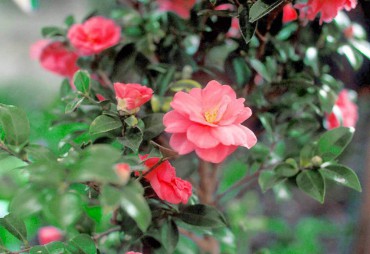
Would you believe you could have a pink rhodie splendiferously blooming in your gardens in the middle of winter’s chill? “Christmas Cheer” is an answer to those longing for cheerful, soft pink blooms in the heart of winter. This is a fairly compact variety, growing to 4-foot by 4-foot in 10 years, and is usually covered with masses of blooms in the dead of winter. Usually the cooler the weather, the happier the blooms.
Whitney Gardens in Brinnon carries “Christmas Cheer,” as might Poulsbo’s Valley Nursery, which has a huge selection of rhodies each year. Other local nurseries in West Sound sell rhodies and may place special orders for them.
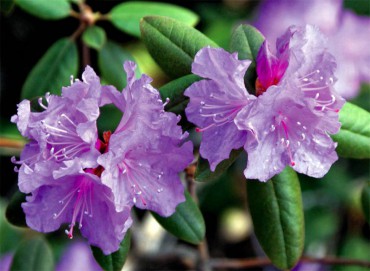 Christmas Cheer can be deceiving though, because it doesn’t always bloom at Christmas or even in December. Some years it waits until January or February to blossom out. It can even bloom to herald the first snow or the first hard frost, which is not always so good since sometimes its blossoms wilt a bit sooner than we’d like. Usually Christmas Cheer blooms continuously from December through March and even into April. It’s worth exploring and finding; it will give lasting enjoyment year after year when not much else is blooming or giving floriferous interest in the garden.
Christmas Cheer can be deceiving though, because it doesn’t always bloom at Christmas or even in December. Some years it waits until January or February to blossom out. It can even bloom to herald the first snow or the first hard frost, which is not always so good since sometimes its blossoms wilt a bit sooner than we’d like. Usually Christmas Cheer blooms continuously from December through March and even into April. It’s worth exploring and finding; it will give lasting enjoyment year after year when not much else is blooming or giving floriferous interest in the garden.
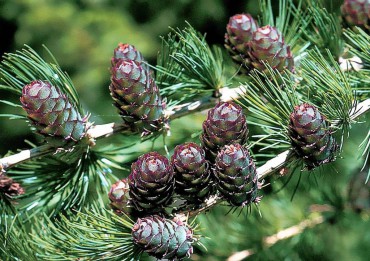 While we’re on the topic of rhodies, gardeners can find a rhody for blooms nearly each month of the year. A winter sweetie is “PJM,” (below) covered with blooms in February and March. It has wonderful bronzy foliage early in the year. Next comes hundreds of petite purple-lavender blossoms. New leaves are almost lime green. PJMs grow taller than they grow wide. This tidy rhody would even be a good container candidate for several years.
While we’re on the topic of rhodies, gardeners can find a rhody for blooms nearly each month of the year. A winter sweetie is “PJM,” (below) covered with blooms in February and March. It has wonderful bronzy foliage early in the year. Next comes hundreds of petite purple-lavender blossoms. New leaves are almost lime green. PJMs grow taller than they grow wide. This tidy rhody would even be a good container candidate for several years.
Search out rhodies in your favorite nursery and look through all the myriad textures and color palettes of both flower and foliage. Make sure you check their height requirements: Some rhodies become extremely large (even tree-like). You will find many varieties of smaller stature and quite suitable for small gardens.
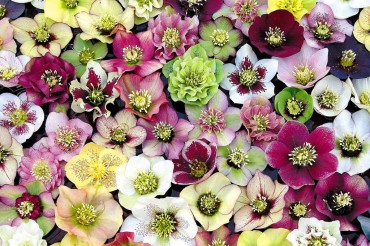
Another delightful and appealing winter plant to find is Camellia sasanqua. It’s smaller in stature than Camelia japonica and is perfect for container plantings. C. sasanqua will bloom in late fall to early winter. Camellia sasanqua “Bonanza” is a low growing, two-foot-tall ground cover camellia. You may have to seek out Bonanza because it can sometimes be hard to locate.
If you can grow rhodies, azaleas, blueberries, huckleberries or heathers in your garden, then camellias will grow there too. Like all plants, you’ll need to water camellias regularly for the first two or three years in your garden until they become established. Camellias prefer dappled shade. Avoid direct sun for most varieties but there are a few that crave and thrive in abundant sunlight. Ask your favorite nursery person for recommendations. You’ll find camellias with flowers in shades of white, pink, red and sometimes yellow. Some varieties have striped flowers. Sasanquas with light fragrances are available too. Imagine a lightly scented sasanqua as an ideal container plant on a front porch or entryway.
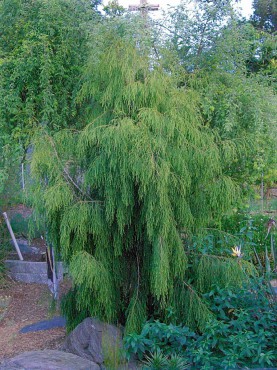
Another stunning winter plant is Callicarpa. Several varieties have vibrant purple berries marching up and down their stems. These varieties look good paired near PJM. The berries this time of year hint of PJM’s blossoms arriving in spring. Callicarpa’s leaves in summer are splashed with chartreuse turning to darker green, followed by crimson and orange in fall. Several choices are available with white berries. Your favorite local nursery will probably have several temptations from which to select. Notice the size descriptions for Callicarpa; some varieties grow quite large. If your space is limited, choose the smallest variety available.
Many ornamental grasses add texture and interest in the winter garden. Any number of bronze carex are excellent choices because even when foliage dies during winter, the bronze colors remain until new foliage emerges in the spring. Carex morowii varieties have wide evergreen leaves bordered in creamy white. A tiny carex morowii would look adorable filling up a square hyper-tufa pot or nested in with other winter foliage in a dramatic vibrant-colored ceramic or stone container.
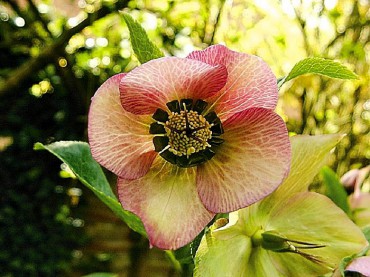 Last but not least, don’t forget to add several hellebores to your winter garden. Hellebores will happily live in containers, love to grow in colonies festooning the garden, make wonderful border plantings and are an all-around seasonal interest plant. Hellebores are often known as Lenten Roses. Buds are beginning to emerge on the hellebore throughout Kitsap County this time of year. There is only one caveat to planting hellebores — some varieties are prone to aphids. If you end up with an aphid-prone hellebore, give yourself permission to compost the plant and move on to another choice. Any opportunity to compost a nonsatisfactory plant gives us the pleasure of heading out to our favorite plant source to buy a replacement. Gardening is never boring.
Last but not least, don’t forget to add several hellebores to your winter garden. Hellebores will happily live in containers, love to grow in colonies festooning the garden, make wonderful border plantings and are an all-around seasonal interest plant. Hellebores are often known as Lenten Roses. Buds are beginning to emerge on the hellebore throughout Kitsap County this time of year. There is only one caveat to planting hellebores — some varieties are prone to aphids. If you end up with an aphid-prone hellebore, give yourself permission to compost the plant and move on to another choice. Any opportunity to compost a nonsatisfactory plant gives us the pleasure of heading out to our favorite plant source to buy a replacement. Gardening is never boring.
Winter is also the time of year to haunt local nurseries on a quest for conifers to add to the gardens. Conifers provide framework, serve as anchor plantings, and satisfy textural needs. You’ll find a conifer to suit any size and space requirement. Bremerton Garden Center, Valley Nursery, Dragonfly Nursery and Savage Plants are among the local nurseries offering abundant choices in evergreen conifers to fit any garden design need. Your own favorite nursery will probably have conifers to fit your wishes. The miniatures and smaller varieties are perfect for containers or tucking into a vacant space in the garden that needs just the right touch of something with easy care. Consider weeping and spreading varieties. Remember too that some conifers have needles that change color through the season and some are even deciduous.
These crisp, clear winter days are perfect for taking a stroll through neighborhoods. Peak into the gardens as you walk by. You may notice plants that shine in chilly weather. Look through the horticulture books from the Dan Hinkley Heronswood-donated collection available at our Kitsap Regional Libraries. Or stroll through your favorite nursery to find some of your own perfect plants for winter gardens. A gardener can never have too many plants.
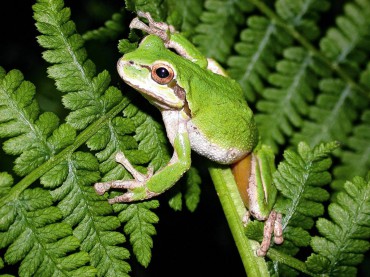 Pacific Tree Frogs
Pacific Tree Frogs
It’s a bit tricky to write about our critter for the winter issue of WestSound Magazine. Most of the outdoor furry creatures and the insects are asleep or hibernating. As we look to spring though, we can hanker for the Pacific tree frog. You’ll hear its nightly chorus beginning in February and lasting into June.
The Pacific tree frog lives in the ponds and streams still surrounding many of our neighborhoods. The males start singing their little hearts out in February to attract a mate. This melodic, raucous and heralding call is referred to as the “frog chorus.” You’ll be able to hear the chorus even with your windows and doors closed. If you live near a pond or stream, roll down your car windows at night as you come home from work. You’ll hear the frogs greeting you. The frog chorus is a pleasant and wondrous song telling us that spring isn’t too far away. Our own Pacific tree frogs have been recorded and their songs have been used in many movies.
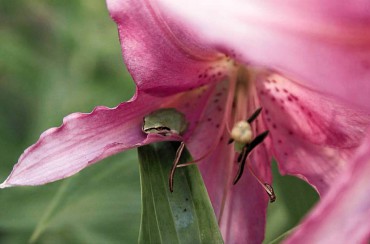 In the summer, when their singing is over for the season, you’ll find them peeking out from dahlias, near water faucets and resting peacefully in your containerized plants. These small creatures have the prettiest bright green and golden eyes. Some of the frogs are the brightest shade of green and some are a beautiful bronze color. They manage to greet us as we pick up the garden hose or watering cans to give our summer flowers a drink of water. One more tidbit about these cute creatures: They eat their weight and then some in insects every day.
In the summer, when their singing is over for the season, you’ll find them peeking out from dahlias, near water faucets and resting peacefully in your containerized plants. These small creatures have the prettiest bright green and golden eyes. Some of the frogs are the brightest shade of green and some are a beautiful bronze color. They manage to greet us as we pick up the garden hose or watering cans to give our summer flowers a drink of water. One more tidbit about these cute creatures: They eat their weight and then some in insects every day.
Find the book “Passionate Slugs and Hollywood Frogs” by Patricia K. Lichen (ISBN 1507612226). The book is charmingly illustrated by Linda M. Feltner. Lichen was a naturalist for many years in Washington and Oregon, helping people discover the wildlife in their own back yards and in the natural surroundings at local parks. Her descriptions have been captured in Sasquatch Books’ “Uncommon Field Guide to Northwest Gardens” series.





























